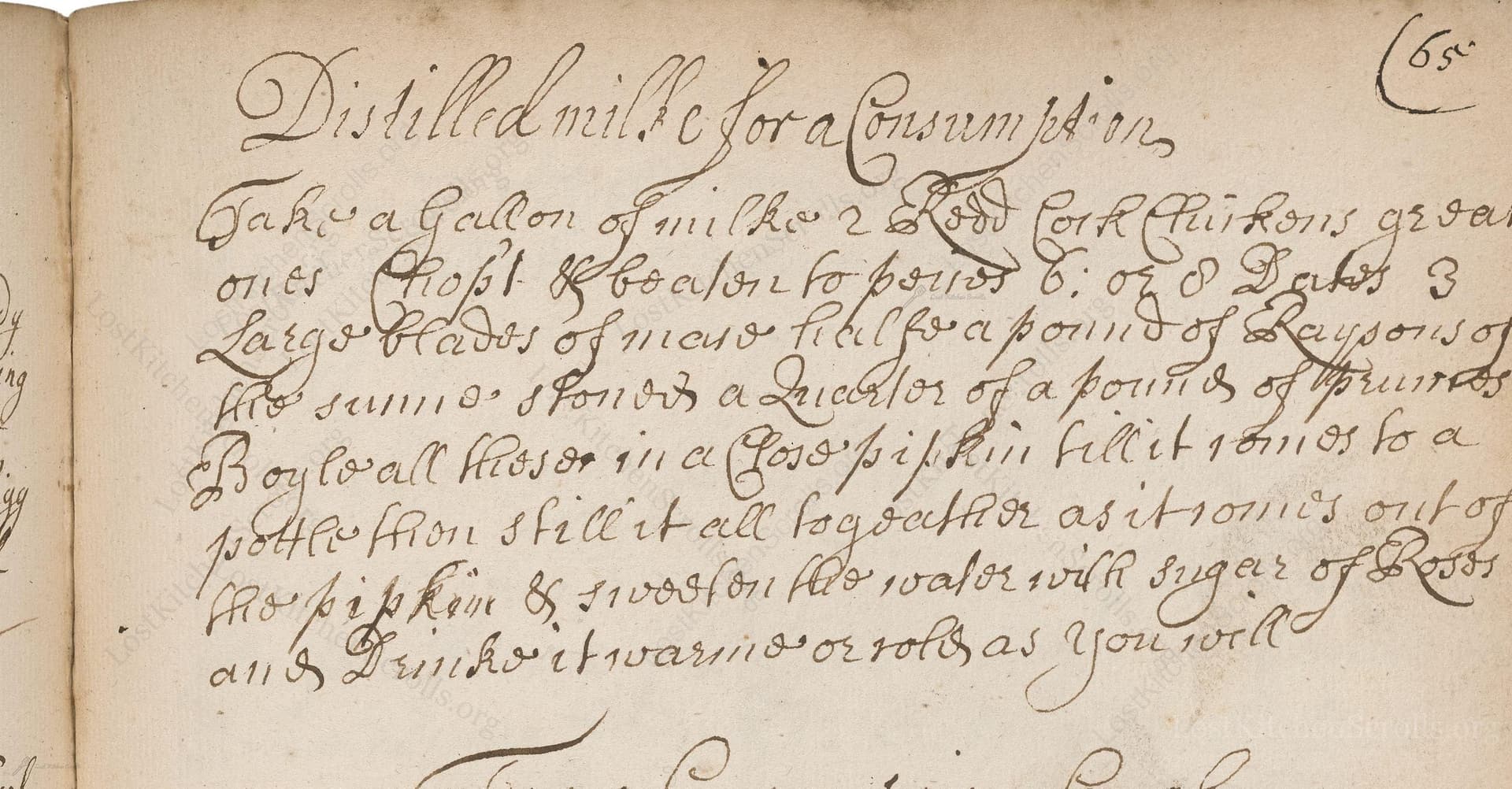Distilled Milke For A Consumption
From the treasured pages of Cookery and medicinal recipes by Kendall Rose and Anne Cater
Written by Rose Kendall, Anne Cater, Elizabeth Clarke, Anna Maria Bold

Distilled Milke For A Consumption
"Take a Gallon of milke & 2 or 3 Cork Chickons great ones Chopt & beaten to peices 6: oz of Dates 3 Large blades of mace half a pound of Raysons of the sunn or Almonds a quarter of a pound of prunns Boyl all these in a Glasse Still pot or Lambick till it comes to a water then Still it all together as it comes out of the pipe keep it sweeten the water with sugar of Rosses and drink it warme or Cold as you will"
Note on the Original Text
The recipe’s language is characteristic of 17th-century English cookbook manuscripts. Quantities are somewhat vague and based on available measures (‘gallon’ for liquids, ounces and pounds for solids), while spelling is phonetic and variable (e.g., 'Chickons' for chickens, 'Raysons of the sunn' for raisins, 'still it' for distill). Instructions are concise, presuming familiarity with kitchen processes of the day. Such recipes often skip details for simmering or preparing the still, relying on the assumed skills of the reader—who was likely a housekeeper or nurse, well-versed in both cookery and household medicine.

Title
Cookery and medicinal recipes by Kendall Rose and Anne Cater (1712)
You can also click the book image above to peruse the original tome
Writer
Rose Kendall, Anne Cater, Elizabeth Clarke, Anna Maria Bold
Era
1712
Publisher
Unknown
Background
Step into the inviting kitchens of the past with this enchanting collection of culinary wisdom from England's early modern era. Crafted by a talented array of women, this book promises savory pies, sweet confections, and secret family recipes—an aromatic tour through centuries-old feasts sure to delight the curious palate.
Kindly made available by
Folger Shakespeare Library
This recipe originates from a collection compiled between 1675 and 1750, drawing together prescriptions and culinary wisdom from several women, including Rose Kendall and Elizabeth Clarke. During this era, recipes for the sick—especially those suffering from 'consumption' (now known as tuberculosis)—offered both sustenance and gentle, medicinal comfort. Recipes like this were prescribed as nourishing tonics, with milk and finely chopped chicken distilled into a restorative 'milk water' often sweetened for palatability and, perhaps, to mask richer, meaty flavors. Such preparations reflected the period’s close intertwining of food and medicine, and the belief that distillation could refine and concentrate nourishment.

The recipe was made using a 'glass still pot or limbeck'—early forms of distillation apparatuses. Such stills commonly appeared on well-off kitchen hearths in the 17th and 18th centuries. The pot would be placed over gentle heat, allowing the vapors to rise through a coiled tube or 'worm' and condense, yielding a clear liquid rich with the essence of all its ingredients. In a modern kitchen, you could use a small countertop still, a steam distiller, or even improvise with a large pot, heat-safe bowl, and lid to catch the condensate drip.
Prep Time
30 mins
Cook Time
2 hrs
Servings
10
We've done our best to adapt this historical recipe for modern kitchens, but some details may still need refinement. We warmly welcome feedback from fellow cooks and culinary historians — your insights support the entire community!
Ingredients
- 4 quarts whole milk
- 2–3 large raw chickens (approx. 3 1/3 pounds total), chopped
- 6 ounces dates, chopped
- 3 large blades of mace
- 8 ounces raisins (or 8 ounces blanched almonds)
- 4 ounces prunes
- Sugar infused with rose petals (or caster sugar with a few drops of rosewater)
Instructions
- To prepare 'Distilled Milk for a Consumption', begin by taking 4 quarts of whole milk and placing it in a large pot.
- Chop 2 or 3 large raw chickens (about 3 1/3 pounds total, skin and bones included) into peices and add them into the milk.
- Add 6 ounces of chopped dates, 3 large blades of mace, 8 ounces of raisins or, for a lighter flavor, blanched almonds.
- Include 4 ounces of prunes.
- Bring the mixture slowly to a simmer.
- Once everything is combined and has simmered gently, strain the solids thouroughly, then distill the liquid using a modern still, distillation kit, or improvise by steam-distilling (see tools).
- Collect the condensed 'milk water' as it comes out.
- Sweeten the resulting liquid with rose sugar (sugar scented with rose petals, or use caster sugar and a few drops of rosewater) to your taste.
- Serve warm or cold.
Estimated Calories
190 per serving
Cooking Estimates
Preparation takes about 30 minutes; you will need to chop the chickens and fruits, and get your workspace ready. Simmering and distillation takes about 2 hours since you need to cook the mixture gently and process it to collect the distilled milk water. Each serving contains about 190 calories, and the recipe makes about 10 servings.
As noted above, we have made our best effort to translate and adapt this historical recipe for modern kitchens, taking into account ingredients nowadays, cooking techniques, measurements, and so on. However, historical recipes often contain assumptions that require interpretation.
We'd love for anyone to help improve these adaptations. Community contributions are highly welcome. If you have suggestions, corrections, or cooking tips based on your experience with this recipe, please share them below.
Join the Discussion
Rate This Recipe
Dietary Preference
Occasions

Den Bockfisch In Einer Fleisch Suppen Zu Kochen
This recipe hails from a German manuscript cookbook compiled in 1696, a time whe...

Die Grieß Nudlen Zumachen
This recipe comes from a rather mysterious manuscript cookbook, penned anonymous...

Ein Boudain
This recipe comes from an anonymous German-language manuscript cookbook from 169...

Ein Gesaltzen Citroni
This recipe, dating from 1696, comes from an extensive anonymous German cookbook...
Browse our complete collection of time-honored recipes



